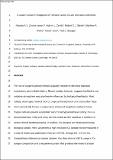A copper isotope investigation of methane cycling in Late Archaean sediments
View/
Date
16/06/2021Author
Funder
Grant ID
NE/J023485/2
Keywords
Metadata
Show full item recordAbstract
The rise of oxygenic photosynthesis arguably represents the most important evolutionary step in Earth history. Recent studies, however, suggest that Earth’s pre-oxidative atmosphere was also heavily influenced by biological feedbacks. Most notably, recent geochemical records propose the existence of a hydrocarbon haze which periodically formed in response to enhanced biospheric methane fluxes. Copper isotopes provide a potential proxy for biological methane cycling; Cu is a bioessential trace metal and a key element in the aerobic oxidation of methane to carbon dioxide (methanotrophy). In addition, Cu isotopes are fractionated during biological uptake. Here, we present a high-resolution Cu isotope record measured in a suite of shales and carbonates from core GKF01, through the ~2.6–2.5 Ga Campbellrand-Malmani carbonate platform. Our data show a 0.85‰ range in Cu isotope composition and a negative excursion that predates the onset of a haze event. We interpret this excursion as representing a period of enhanced aerobic methane oxidation before the onset of the Great Oxidation Event. This places valuable time constraints on the evolution of this metabolism and firmly establishing Cu isotopes as a biomarker in Late Archaean rocks.
Citation
Zavina-James , N A V , Zerkle , A L , Steele , R C J , Warke , M R , Izon , G & Savage , P S 2021 , ' A copper isotope investigation of methane cycling in Late Archaean sediments ' , Precambrian Research , vol. In press , 106267 . https://doi.org/10.1016/j.precamres.2021.106267
Publication
Precambrian Research
Status
Peer reviewed
ISSN
0301-9268Type
Journal article
Description
This research was supported by NERC award NE/L002590/1 to the IAPETUS DTP, and by NERC Standard Grant NE/J023485/2 to A.L.Z. The initiation of Cu isotope analysis at the University of St Andrews was aided significantly by a Carnegie Trust Research Incentive Grant awarded to P.S.S.Collections
Items in the St Andrews Research Repository are protected by copyright, with all rights reserved, unless otherwise indicated.

